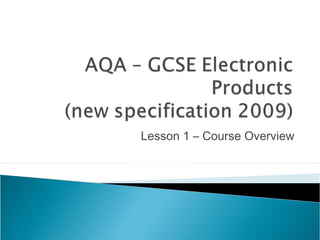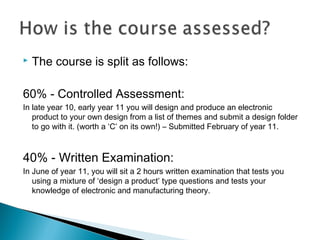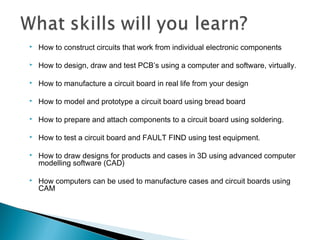Electronic Products - Year 10 - Introduction to Course
- 1. Lesson 1 ŌĆō Course Overview
- 2. ’üĮ The course is split as follows: 60% - Controlled Assessment: In late year 10, early year 11 you will design and produce an electronic product to your own design from a list of themes and submit a design folder to go with it. (worth a ŌĆśCŌĆÖ on its own!) ŌĆō Submitted February of year 11. 40% - Written Examination: In June of year 11, you will sit a 2 hours written examination that tests you using a mixture of ŌĆśdesign a productŌĆÖ type questions and tests your knowledge of electronic and manufacturing theory.
- 3. ’üĮ How to construct circuits that work from individual electronic components ’üĮ How to design, draw and test PCBŌĆÖs using a computer and software, virtually. ’üĮ How to manufacture a circuit board in real life from your design ’üĮ How to model and prototype a circuit board using bread board ’üĮ How to prepare and attach components to a circuit board using soldering. ’üĮ How to test a circuit board and FAULT FIND using test equipment. ’üĮ How to draw designs for products and cases in 3D using advanced computer modelling software (CAD) ’üĮ How computers can be used to manufacture cases and circuit boards using CAM
- 4. ’üĮ How to design a case for an electronic product using a variety of materials ŌĆō what features a QUALITY electronic product must possess and how to add these in ’üĮ How to generate amazing design ideas for products through research, analysis, design development and evaluation ŌĆō The DESIGN PROCESS .... As used in real life! ’üĮ How to manufacture appropriate cases for your electronic circuits using plastics, woods, metals and various other materials. ’üĮ How to use equipment and workshop machinery that allows you to work and form the above materials. ’üĮ How to produce ŌĆśprogrammableŌĆÖ electronic circuits using PIC chips and how to write a program using flow charts and logic. ’üĮ How to design products for the future world which are sustainable, recyclable and environmentally friendly. ’üĮ How to be awesome...... You will learn this from me.
- 5. This course will pave the way for careers in: - Electronic product design...... Well, Duhh! - As an electrician - In MANY different engineering industries ŌĆō i.e aeronautic / motorsport courses, civil engineering, electrical engineering, aerospace. - In the manufacturing industry. - As a product designer, including CAD industry. - Also it is considered by most colleges and universities as a relevant qualification for accepetemce to study a course related to any of the above. - Finally, you will learn skills that will might allow you to fix and repair things at home and save you money ŌĆō Bonus
- 6. Little bit of an ice breaker this one.... Working in groups of 3, you are to use ALL the items in the bag on your table to make a circuit that works! - IŌĆÖm not even going to tell you what it should do. You have 5 minutes. - If you canŌĆÖt do it, you will be considered not awesome (this is part 1 of the awesomeness training) The only piece of help I will give you is as follows:
- 7. Help!
- 8. ’üĮ As a groupŌĆ”.. ’üĮ Identify the pictures of the components that are on your table and match them with the correct name, and description on the smart board.
- 9. ’üĮ Assemble and test the circuit you built today in virtual reality using a piece of software called circuit wizard. ’üĮ Click the ŌĆśApplicationsŌĆÖ folder on the desktop, then the folder ŌĆśTechnologyŌĆÖ then CIRCUIT WIZARD. ’üĮ Find the CIRCUIT SYMBOLS for the components you have learned about today in ŌĆśthe galleryŌĆÖ and try and assemble them into a working circuit.
- 10. ’üĮ Answer the following questionsŌĆ” ’üĮ How is this GCSE course assessed? ’üĮ What knowledge will you learn on the course? ’üĮ What Careers or further education might this help you in? ’üĮ What is Breadboard? WHAT HAVE YOU LEARNED TODAY?
- 11. ’üĮ What does a resistor do? ’üĮ What does L.E.D stand for? ’üĮ What is the difference between a component and a component symbol? WHAT HAVE YOU LEARNED TODAY?
- 12. ’üĮ Sum up what each of the 3 terms below mean in no more than 20 words for each, and without copying from wikipedia. Current, Potential Difference, Resistance Extra awesomness bonus if you can tell me what their ŌĆśunit of measurementŌĆÖ is. Note: - Home learning DOES count towards your report gradeŌĆ”.. But its you choice if you do it. Home Learning Task:











